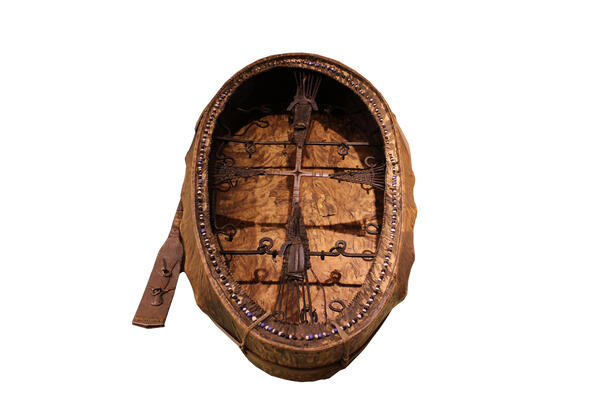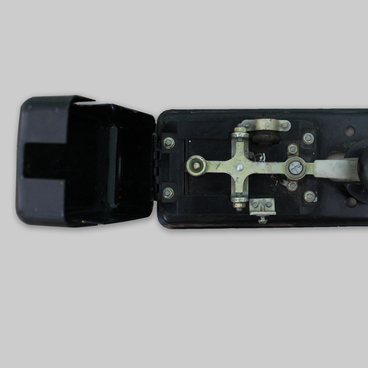The shaman’s wooden and wide tambourine is covered with well-tanned deer skin. On the wooden side there are “ears” corresponding to the power of the shaman. The stronger the spirit of the shaman, the more “ears” on the tambourine. The shaman’s tambourine was often called a kind of raft or boat by Evenki people, and the beater of the tambourine — an oar. On this ‘raft’ the shaman’s soul “floated” through underground rivers and lakes in search of lost souls or in pursuit of stolen souls.
The tambourine had a rounded shape; its diameter was from 75 to 99 cm, and the width of the rim could be from 13 to 18 cm. The rim was made of cedar using a special device. The skin for the tool was made by women from the shaman’s family. On the outside of the tambourine, schematic images of anthropomorphic figures were applied. On the inside, it was reinforced with transverse iron bars, on which iron pendants and figures of animals and birds were tied.
The shaman’s influence on people and faith in him were enormous, since his main task was to take care of the souls of his relatives and their well-being. He was called to the sick, asked about the future, asked to bring good luck. During the rituals, the shaman moved to other worlds, where he communicated with spirits, searched for and found lost human souls. The shaman also possessed the power to summon storm, rain, thunder, and lightning.
In addition, before leaving for expedition on a difficult journey down the river, the Evenki shaman arranged the so-called send-offs, performing rituals with a wooden idol of taimen (delbon). This was necessary for reconnaissance of the fairway and the successful completion of the expedition. The ritual of communication with spirits, or rituals, took place without a tambourine and without a shaman’s costume. The shaman sat in a tent on a symbolic raft and held the idol of delbon by the tail in his right hand, with its head facing down. While in this position, he swayed to the right and left and sang, imitating dialogues with delbon. Poking delbon’s head into the ground, the shaman ordered to quickly swim along the Chuni river, carefully examine the bottom of the river, and report to the shaman the results of the exploration at each stretch and at each turn.
The tambourine was considered a reflection of the shaman’s life energy, so the safety of the instrument was always carefully monitored. After the death of the shaman, his tool, like other things, was cut — the Evenks believed that everything would be good in the afterlife. The cut things were put on the shaman’s grave.
The tambourine had a rounded shape; its diameter was from 75 to 99 cm, and the width of the rim could be from 13 to 18 cm. The rim was made of cedar using a special device. The skin for the tool was made by women from the shaman’s family. On the outside of the tambourine, schematic images of anthropomorphic figures were applied. On the inside, it was reinforced with transverse iron bars, on which iron pendants and figures of animals and birds were tied.
The shaman’s influence on people and faith in him were enormous, since his main task was to take care of the souls of his relatives and their well-being. He was called to the sick, asked about the future, asked to bring good luck. During the rituals, the shaman moved to other worlds, where he communicated with spirits, searched for and found lost human souls. The shaman also possessed the power to summon storm, rain, thunder, and lightning.
In addition, before leaving for expedition on a difficult journey down the river, the Evenki shaman arranged the so-called send-offs, performing rituals with a wooden idol of taimen (delbon). This was necessary for reconnaissance of the fairway and the successful completion of the expedition. The ritual of communication with spirits, or rituals, took place without a tambourine and without a shaman’s costume. The shaman sat in a tent on a symbolic raft and held the idol of delbon by the tail in his right hand, with its head facing down. While in this position, he swayed to the right and left and sang, imitating dialogues with delbon. Poking delbon’s head into the ground, the shaman ordered to quickly swim along the Chuni river, carefully examine the bottom of the river, and report to the shaman the results of the exploration at each stretch and at each turn.
The tambourine was considered a reflection of the shaman’s life energy, so the safety of the instrument was always carefully monitored. After the death of the shaman, his tool, like other things, was cut — the Evenks believed that everything would be good in the afterlife. The cut things were put on the shaman’s grave.



